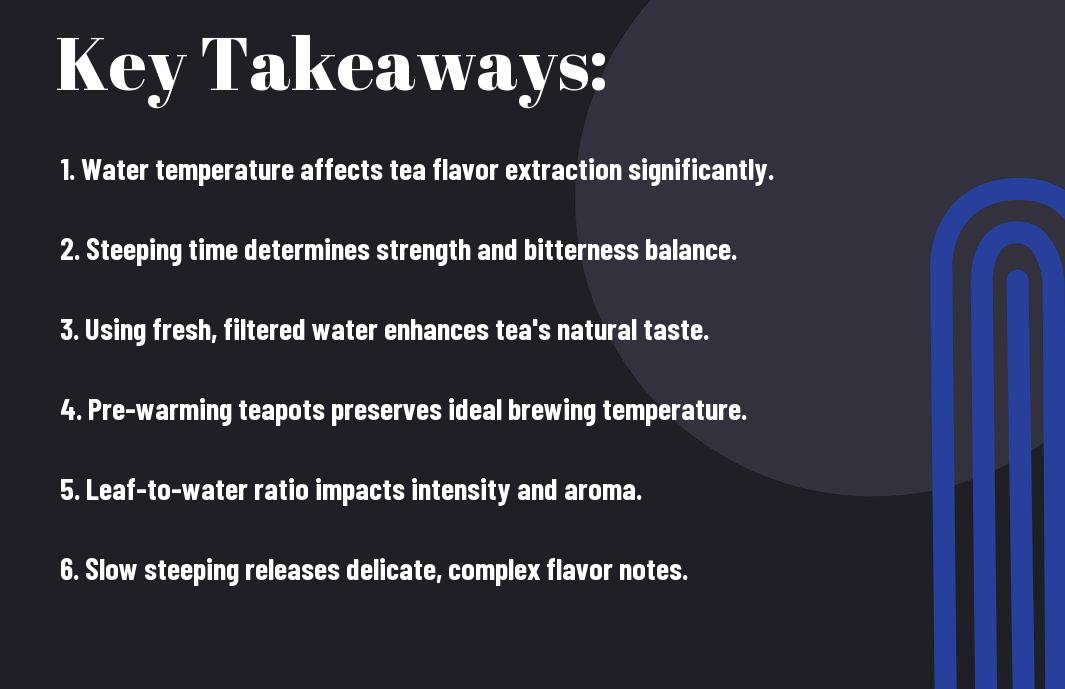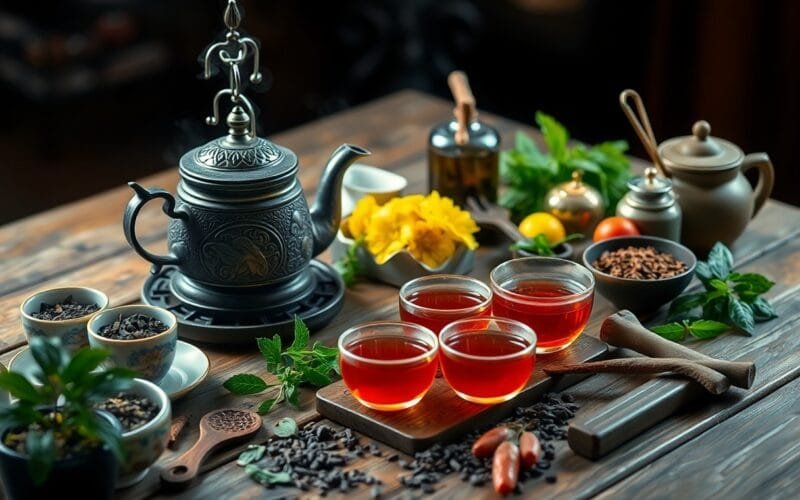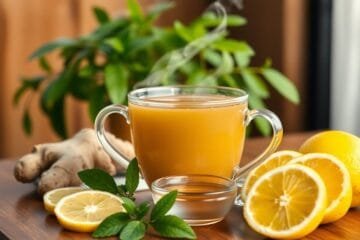Just as your favorite blend of tea brings comfort, the ancient brewing secrets passed down through generations can transform your tea-drinking experience. Knowing how to unlock the full potential of your leaves can lead to a cup that boasts enhanced flavor and unmatched aroma, making each sip a delightful journey. Whether you’re a novice or a seasoned enthusiast, integrating these time-honored techniques into your routine can elevate your rituals. Don’t miss out on tips that many passionate tea lovers swear by—as seen in this video for all my tea lovers I SWEAR BY IT 🫖💛 #tea ….
Key Takeaways:
- Ancient brewing methods enhance flavors and aromas, allowing tea lovers to experience a richer taste profile with each cup.
- Temperature and steeping time play vital roles in extracting the best qualities from tea leaves, resulting in a more balanced and enjoyable brew.
- The use of specific materials and tools in traditional brewing can impact the overall quality of tea, contributing to a more authentic drinking experience.

Rediscovering Ancient Techniques
Exploring the art of tea brewing through ancient techniques opens up a world of flavors that modern methods often overlook. With time-honored practices passed down through generations, you can uncover the profound wisdom behind extracting the best qualities from tea leaves. Whether it’s through temperature control, steeping times, or the essence of specific utensils, these techniques enrich your overall tea experience, allowing for unique tastings that celebrate tradition while enhancing your daily ritual.
The Ritual of Tea Preparation
Your tea-making process can transform into a mindful experience, reminiscent of rituals performed by ancient tea masters. Cultivating intention in each step—from selecting your leaves to timing your steep—enhances not just the flavor but your connection to the beverage. This mindfulness becomes part of the ritual, making your tea time not just about hydration, but also a moment of personal reflection and serenity.
Historical Context and Cultural Significance
The roots of tea preparation run deep, entwined with the cultural histories of countries like China, Japan, and India. In these cultures, tea is revered not merely as a drink but as a symbol of hospitality and community. Traditional ceremonies, such as the Japanese tea ceremony, emphasize graceful movements and the aesthetic enjoyment of both tea and nature, promoting a sense of harmony.
Across centuries, tea has adapted in its significance, manifesting differently in various societies. In China, for example, tea culture dates back nearly 5,000 years, with the legend of Emperor Shen Nong discovering tea leaves in boiling water. This historical context offers insight into how tea was originally a medicinal drink before evolving into a beloved daily pleasure. Cultural rituals continue to play a pivotal role in shaping your perspective on tea, reminding you to appreciate not only the beverage itself but also the stories and traditions behind it. Engaging with these ancient practices can deepen your appreciation for tea, enriching each cup with a sense of heritage and artistry.
The Science of Water: The Essential Element
You might not realize it, but the quality of the water you use profoundly impacts your tea’s flavor. Tap water, with its varying mineral content, can alter the taste profile of your brew. Purified, spring, or distilled water each creates a unique taste experience. Next time you’re in the mood for tea, consider your water source. Feeling adventurous? Join discussions like Everyone talks about coffee while camping, but what … to find tips from fellow tea enthusiasts.
Water Quality: Hard vs. Soft
Hard water contains higher levels of minerals like calcium and magnesium, which can significantly affect your tea’s flavor. Soft water, with fewer minerals, allows the natural notes of your tea to shine through. If you want to achieve the purest flavor, opt for soft water, as it prevents unwanted metallic tastes and helps elevate your beverage experience.
Temperature and Its Impact on Flavor
Each tea type has an ideal brewing temperature that unlocks its unique flavors. For instance, green teas thrive at lower temperatures (around 160-180°F), while black teas prefer higher ranges (around 200-212°F). Brew your green tea too hot, and it will taste *bitter*, while *under-brewing* black tea results in a weak infusion that lacks depth. Finding the perfect temperature is key to providing a balanced cup of tea that celebrates its natural nuances.
Exploring the temperature variables is vital for achieving the best results. The infusion process begins once the leaves come into contact with hot water, and the higher the heat, the quicker the extraction of flavors. Under-brewing often leads to a lack of robust taste, while over-brewing at excessively high temperatures can create an overly astringent cup. Striking the right balance allows for an enhanced flavor profile that reflects the tea’s origin and quality.
| Water Type | Effect on Flavor |
| Hard Water | May introduce metallic notes, affecting overall taste |
| Soft Water | Enhances natural tea flavors, providing a cleaner taste |
| Tea Type | Ideal Temperature (°F) |
| Green Tea | 160-180°F |
| Black Tea | 200-212°F |
Leaf to Liquid: The Art of Proportion
Mastering the art of proportion is important to ensure your tea is perfectly balanced in flavor. The ratio of tea leaves to water can make all the difference between a delightful brew and an overpowering cup. Achieving that harmony requires a delicate touch, where the right amount of leaves steeped in the proper temperature water yields a tea experience that tantalizes your taste buds. You’ll appreciate the nuances of each variety, learning how to elevate your steeps from mundane to magnificent.
Understanding Different Types of Tea Leaves
Each type of tea leaf carries its own unique qualities, influencing both the brewing method and the proportion of leaves used. Recognizing these differences helps you to create a superior cup. Here’s a quick breakdown:
| Green Tea | Light and delicate, requires a lower leaf-to-water ratio. |
| Black Tea | Bold in flavor, often needs a higher ratio of leaves. |
| Oolong Tea | Semi-oxidized, can vary in strength and requires adjustment in proportion. |
| Herbal Tea | Varied flavors, typically a larger quantity of leaves for a robust brew. |
| White Tea | Subtle and sweet, benefits from a careful balance due to its delicate nature. |
After you familiarize yourself with these distinctions, you will be better equipped to brew the perfect cup tailored to your tastes.
The Golden Ratio: Striking the Perfect Balance
Finding the golden ratio between tea leaves and water unlocks the true potential of your brew. Generally, a guideline of one teaspoon of loose leaf per cup (8 oz) of water suffices, although this can vary based on the tea type and your personal preference. The right balance enhances your tea’s natural flavors, preventing unpleasant bitterness or a flat taste. Experimenting with this ratio will help you discover how subtle adjustments yield significantly different results in your daily brews.
Adjusting your tea-to-water ratio is akin to fine-tuning a musical instrument; even small changes can lead to delightful or discordant results. For instance, you might find that black tea thrives on a full teaspoon per cup for a robust flavor, while green tea may benefit from just a half teaspoon to preserve its delicate aromas. As you brew, consider factors like steeping time and water temperature. These elements interplay with your proportions, guiding you toward the perfect cup tailored to your palate. With practice, you will gain confidence and insight into your ideal brewing ratios, unlocking a spectrum of flavors previously unknown to you.
Steeping Secrets: Unlocking Flavor Profiles
Understanding the art of steeping is necessary for bringing out the diverse flavor profiles of your tea. Whether you’re sipping a delicate white or a robust black, the right steeping parameters can elevate your experience significantly. Factors like water temperature, steeping time, and even the choice of vessel can influence the taste, aroma, and overall quality of your brew. By mastering these elements, you can unlock the subtle nuances each variety has to offer, transforming your routine cup into something extraordinary.
Timing Your Steep for Optimal Taste
Every tea variety has its own specific steeping time that unlocks the best flavors without bitterness. For example, green teas typically require just 2-3 minutes at lower temperatures (about 160-180°F) to preserve their delicate taste, while black teas thrive with longer steeping times of 3-5 minutes at higher temperatures (around 200-212°F). Experimenting with these variables allows you to fine-tune your brew and discover what suits your palate the most.
Exploring Infusion Methods: From Traditional to Modern
Infusion methods greatly impact your tea’s flavor and experience. Classic tools like the teapot or French press allow for an intimate connection with traditional brewing practices, while modern devices such as electric kettles or tea infusers streamline the process with precision temperature control. Each method has its nuances: a teapot might enhance the aesthetic appeal of your brew, while a French press could maximize flavor extraction. The rapid advancement in tea brewing technology opens a world of options, allowing you to blend tradition with innovation, tailoring your experience to meet your unique preferences.
Elevating the Experience: Presentation and Accoutrements
Transforming your tea ritual into an extraordinary experience involves not just the brewing techniques, but also the presentation and thoughtful accoutrements. Engaging your senses through visual appeal and additional elements—like the perfect vessel and delightful accompaniments—can heighten your enjoyment and enhance the flavor of each cup. Discover how to refine your tea experience to elevate not only the taste but also the entire ritual surrounding it.
Choosing the Right Vessel for Brewing
The vessel you select for brewing can greatly influence the tea’s flavor and aroma. Options range from delicate porcelain teapots to robust cast iron varieties, each imparting its own unique characteristics. For instance, ceramic pots retain heat effectively, making them ideal for black teas, while glass teapots allow you to appreciate the unfolding beauty of herbal blends. Choose a vessel that complements your tea type, as the material and shape directly affect your tea-drinking experience.
Enhancing Flavor with Accompaniments
Accompaniments and garnishes can elevate your tea experience significantly. Sweeteners such as honey or agave syrup, along with fresh herbs like mint or traditional lemon slices, can transform your brew into an invigorating treat. Adding a pinch of spices, like cinnamon or cardamom, enhances depth and complexity. Don’t shy away from experimenting with different pairings, as they can open up new flavor dimensions and create personalized profiles for your favorite teas.
For example, have you tried adding a hint of lavender to your chamomile tea? The floral notes harmonize beautifully, creating a soothing aroma and an enriched taste. Herbs and spices not only add flavor but also provide health benefits; saffron in your green tea can boost mood, while a dash of ginger in chai offers anti-inflammatory properties. Each accompaniment you choose not only complements the main tea but also reflects your palate and mood, turning a simple cup into a canvas for culinary creativity.
Conclusion
With this in mind, embracing these ancient brewing secrets can elevate your tea experience to new heights. By understanding the nuances of temperature, steeping times, and the distinct characteristics of different tea leaves, you can unlock a world of flavors that will truly enhance your appreciation for this beloved beverage. As a tea lover, applying these time-honored techniques will not only refine your brewing skills but also deepen your connection to the rich cultural heritage behind every cup. Enjoy your journey into the art of tea brewing!
FAQ
Q: What are the ancient brewing secrets that tea lovers swear by?
A: Ancient brewing secrets often involve specific techniques and methods passed down through generations, focusing on the quality of water, tea leaf selection, and steeping times. For instance, many tea enthusiasts recommend using filtered or spring water to enhance the flavor of the tea. Additionally, using the right temperature for different types of tea—such as cooler water for green tea and boiling water for black tea—can vastly improve the taste. Lastly, steeping times are specific; green tea generally requires a shorter steep time than herbal teas, ensuring that you extract the optimal flavor without bitterness.
Q: How do the ancient methods differ from modern tea brewing techniques?
A: Ancient methods often prioritize the purity and quality of ingredients, emphasizing natural flavors and aromas without additives. Modern techniques may include the use of teabags and instant teas, which can be convenient but often sacrifice the depth of flavor found in loose-leaf teas. Additionally, ancient practices often engage all the senses, from the visual appeal of tea leaves to the aroma released during brewing, creating a more immersive experience compared to the more straightforward modern methods.
Q: Can anyone master these ancient brewing techniques, or do they require special skills?
A: Mastering these ancient brewing techniques doesn’t require extraordinary skills, but it does involve a bit of patience and practice. Understanding the basics of water temperatures and steeping times is imperative, but the nuances come with experience. Many tea lovers find joy in experimenting with different types of tea, water sources, and brewing times to discover what works best for their palate. With dedication and an open mind, anyone can appreciate and perfect these ancient secrets for a delightful tea experience.




